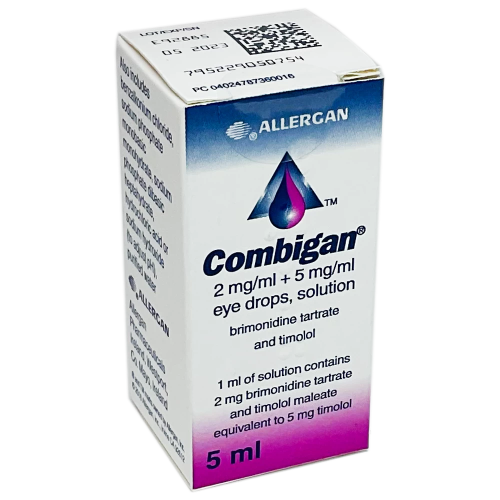Manufacturer: Allergan
Pharmaceutical name: Brimonidine Tartrate, Timolol
Pack: 1 bottle (5 ml (0.2%/0.5%))
Combigan is administered as eye drops to reduce elevated intraocular pressure in glaucoma, particularly in cases of open-angle glaucoma. It is particularly utilized when beta-blocker therapy alone is not tolerated or fails to provide the desired outcome.
The active components are Timolol and Brimonidine. Timolol is classified as a non-selective beta-blocker, meaning it does not specifically bind to beta-receptors. Additionally, it exhibits no intrinsic sympathomimetic activity (ISA). Timolol acts by inhibiting beta-receptors in the eye's ciliary body, which decreases the production of aqueous humor. This decrease in aqueous humor leads to a reduction in intraocular pressure. Timolol's potency is significantly greater than that of propranolol. The lipophilic nature of Timolol ensures good absorption when taken orally, with a bioavailability of approximately 50 to 60%. The plasma half-life of Timolol is around 4 to 5 hours, and it is metabolized in the liver by up to 80%. Timolol binds to plasma proteins at a rate of 60%, with 30% excreted through feces and 70% via urine.
Brimonidine is part of the alpha-sympatholytic drug class. It specifically binds to alpha-receptors in the eye. These receptors are specific binding sites for the sympathetic fibers of the autonomic nervous system, usually activated by the body’s own neurotransmitters, such as epinephrine and norepinephrine. Brimonidine displaces these endogenous neurotransmitters from the receptors, thus inhibiting their effects. The biological half-life of brimonidine is roughly four hours.
During pregnancy, Combigan should be used only if deemed absolutely necessary by a doctor. It is contraindicated for breastfeeding women. Combigan is not recommended for newborns and children. It should only be used in patients with severe or untreated cardiovascular disease, depression, vascular disease (such as reduced blood flow in brain or coronary arteries, Raynaud's syndrome, and Winiwarter-Buerger's disease), and orthostatic hypotension following a thorough medical evaluation of risks versus benefits. The same caution applies to patients with liver or kidney impairment.
Combigan should not be administered while wearing soft contact lenses. Hard contact lenses must be removed before application, and Combigan should be used only after a waiting period of 15-20 minutes. If a dose is missed, take it as soon as remembered; however, if it is too close to the time for the next dose, skip the missed dose and continue with the regular schedule.
Common side effects associated with Combigan use include watering eyes, dryness, redness, headaches, dizziness, fatigue, fainting, depression, bradycardia, coughing, signs of an allergic reaction, nausea, vomiting, diarrhea, and decreased appetite.

